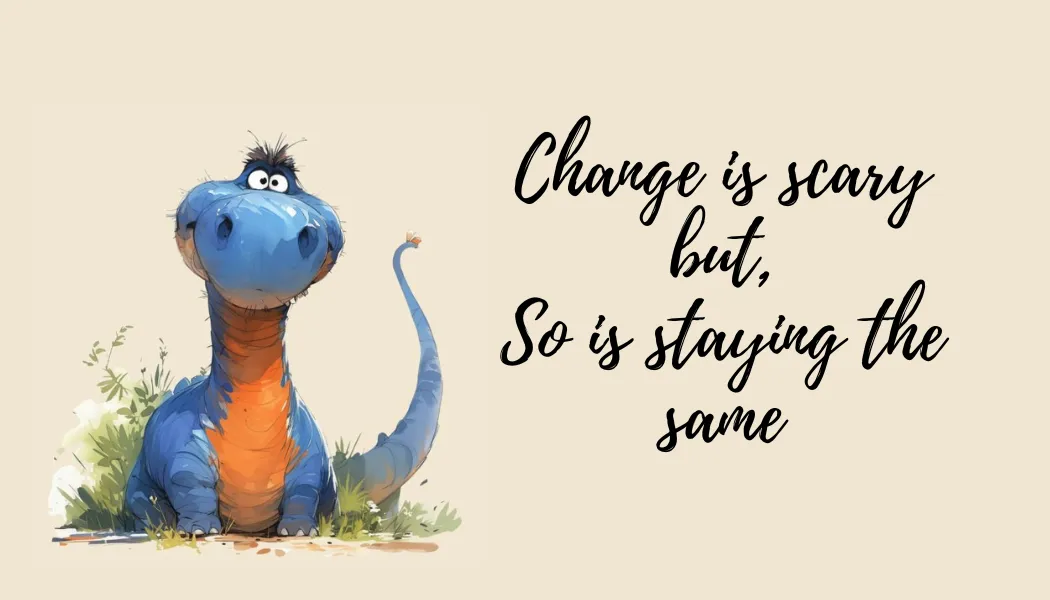Change — it’s one of the most terrifying yet transformative forces in life. The simple phrase, “Change is scary, but so is staying the same,” captures a profound truth about human nature. We often fear stepping into the unknown, clinging to the familiar even when it limits us. But what we rarely acknowledge is that stagnation carries its own kind of fear — the quiet dread of a life that never evolves. Whether in our personal development, careers, or relationships, change is inevitable. The question isn’t whether change will happen — it’s whether we’ll resist it or embrace it.
In today’s rapidly shifting world, adaptability has become more than a skill; it’s a survival mechanism. Yet, emotionally, many of us still wrestle with transitions. From changing jobs or moving cities to breaking old habits or healing from loss, every transformation demands courage. To truly thrive, we must learn not only to accept change but to see it as a path to growth and renewal.
Table of contents
- 1. The Psychology Behind the Fear of Change
- 2. The Hidden Cost of Staying the Same
- 3. Change as a Catalyst for Growth
- 4. The Role of Mindset in Navigating Change
- 5. Real-Life Examples: Triumph Through Change
- 6. The Emotional Rollercoaster of Change
- 7. The Power of Small Changes
- 8. Letting Go: The Art of Surrender
- 9. Change and the Modern World
- 10. Building Emotional Resilience
- 11. Finding Purpose Through Change
- 12. The Beauty of Becoming
- Conclusion: Choosing Courage Over Comfort
1. The Psychology Behind the Fear of Change
Fear of change, or metathesiophobia, is deeply rooted in our biology. Human beings are wired for predictability because it keeps us safe. Our brains are designed to conserve energy, preferring routines and familiar environments where outcomes are predictable. When faced with uncertainty, our amygdala — the brain’s fear center — triggers anxiety, even when the change is potentially positive.
But this instinctive aversion to change can also trap us. It prevents us from taking risks that might lead to greater satisfaction and fulfillment. For instance, how many people stay in jobs they hate or relationships that no longer bring joy simply because they’re afraid of what lies beyond? The comfort zone may feel safe, but it can also become a silent prison.
Understanding this fear is the first step toward overcoming it. When we acknowledge that fear is a natural response, not a reflection of our capabilities, we begin to loosen its grip. Courage is not the absence of fear but the decision to move forward despite it.
2. The Hidden Cost of Staying the Same
While change brings uncertainty, staying the same brings decay. Growth is a fundamental law of nature — everything that lives must evolve or eventually wither. The same applies to human potential. When we resist change, we stop learning, adapting, and challenging ourselves. This stagnation leads to frustration, burnout, and even depression.
Imagine a river that stops flowing. Over time, it becomes stagnant, filled with debris and devoid of life. Similarly, when we stop moving forward in life, our mental and emotional vitality begins to fade. The comfort zone becomes a dead zone — predictable but lifeless.
Many people underestimate how much staying the same costs them. It can cost them dreams left unfulfilled, relationships that never deepen, and opportunities that slip by unnoticed. The fear of change protects us from discomfort in the short term, but it also robs us of the long-term joy that comes from growth.
3. Change as a Catalyst for Growth
Growth and change are inseparable. Every personal transformation — whether chosen or imposed — offers lessons that shape our character and expand our resilience. Consider the major milestones of your life: finishing school, starting a new job, moving to a new place, or recovering from heartbreak. None of these transitions were easy, yet each one contributed to your personal evolution.
Psychologists often describe change as a “growth edge” — the point at which learning and discomfort meet. It’s where transformation happens. When we lean into that discomfort, we stretch our limits and discover strengths we never knew existed.
The truth is, growth rarely happens in moments of comfort. It happens in moments of challenge — when we’re forced to adapt, innovate, and redefine who we are. Like a seed that must break through its shell to become a tree, we too must break through our limitations to reach our potential.
4. The Role of Mindset in Navigating Change
One of the most powerful tools for embracing change is cultivating a growth mindset, a concept introduced by psychologist Carol Dweck. People with a growth mindset believe that abilities and intelligence can be developed through effort, learning, and perseverance. Those with a fixed mindset, on the other hand, see their traits as static — something they must protect rather than expand.
When you view change through the lens of a growth mindset, every challenge becomes an opportunity for learning. Setbacks become feedback, not failures. You stop asking, “Why is this happening to me?” and start asking, “What is this teaching me?”

To nurture this mindset:
- Replace “I can’t” with “I can learn.”
- View mistakes as stepping stones, not obstacles.
- Focus on progress, not perfection.
- Surround yourself with people who inspire, not discourage, growth.
A growth mindset transforms fear into curiosity — and curiosity is the beginning of transformation.
5. Real-Life Examples: Triumph Through Change
Throughout history, countless individuals have turned the fear of change into fuel for greatness. Consider Steve Jobs, who was fired from Apple, the very company he founded. Instead of succumbing to despair, he used that setback to innovate — founding Pixar and eventually returning to Apple to redefine technology forever. Or J.K. Rowling, who faced years of rejection before “Harry Potter” became a global phenomenon. Each story demonstrates that discomfort, when harnessed, can lead to remarkable outcomes.
Even outside of fame, everyday heroes — entrepreneurs, students, parents, and dreamers — face life-altering changes with resilience. A person changing careers at 40, a student moving abroad for education, or someone recovering from loss — all embody the courage it takes to move beyond fear. Their strength reminds us that every ending can be a new beginning in disguise.
6. The Emotional Rollercoaster of Change
Change doesn’t happen in a straight line. It’s an emotional rollercoaster with stages of excitement, fear, doubt, and eventual acceptance. Psychologist William Bridges described this as the Transition Model, which includes three stages:
- Ending – letting go of the old.
- Neutral Zone – the in-between phase filled with uncertainty.
- New Beginning – embracing the new identity or situation.
Understanding this cycle helps us navigate emotions more compassionately. When we feel lost in transition, it’s not a sign of weakness but part of the natural process. The key is to stay patient and kind to ourselves as we adapt. Over time, what once felt foreign becomes familiar, and what once felt impossible becomes routine.
7. The Power of Small Changes
Not all change needs to be dramatic. Sometimes, the most transformative shifts begin with small, consistent actions — waking up earlier, adopting a new hobby, or practicing gratitude. These micro-changes compound over time, reshaping habits, attitudes, and even identity.
For example, committing to 10 minutes of reading daily can evolve into a lifelong love of learning. Replacing negative self-talk with affirmations can gradually rebuild confidence. When we make change manageable, we make it sustainable. As James Clear notes in Atomic Habits, “You do not rise to the level of your goals, you fall to the level of your systems.” Small, steady improvements build the foundation for big transformations.
8. Letting Go: The Art of Surrender
One of the hardest parts of embracing change is letting go — of control, of expectations, and sometimes of people or versions of ourselves. Yet surrendering doesn’t mean giving up. It means trusting the process. Life rarely unfolds according to plan, but that doesn’t mean it’s unfolding wrongly.
Letting go teaches us humility and resilience. It reminds us that we can’t control everything, but we can control how we respond. It’s the difference between fighting the current and learning to swim with it. When we surrender to change with openness, we discover a sense of peace even amid uncertainty.
9. Change and the Modern World
In the digital age, change happens faster than ever — industries evolve overnight, technology redefines human interaction, and societal norms shift rapidly. In such a world, adaptability is the ultimate strength. The most successful individuals and organizations are those that evolve continuously.
Yet, with constant change comes change fatigue — the mental exhaustion from having to adapt endlessly. The antidote lies in balance: embracing change without losing our sense of identity. To thrive in this era, we must pair adaptability with mindfulness — grounding ourselves even as the world spins faster.
10. Building Emotional Resilience
Resilience is the bridge between fear and growth. It’s the inner strength that allows us to bounce back from challenges and view change as an opportunity, not a threat. Building resilience involves:

- Self-awareness: Recognizing emotions instead of suppressing them.
- Optimism: Believing that challenges can lead to positive outcomes.
- Flexibility: Being willing to adjust plans as needed.
- Support systems: Leaning on relationships during times of uncertainty.
Resilient people don’t avoid difficulty; they engage with it constructively. They understand that life is not about avoiding storms but learning to dance in the rain.
11. Finding Purpose Through Change
At its core, change often guides us toward purpose. Many life-altering events — from job loss to heartbreak — force us to ask, “What truly matters?” In answering that question, we discover deeper meaning. Change strips away illusions, revealing our authentic desires and values.
Purpose gives direction to change. It transforms chaos into clarity. When we align our changes with our purpose, transitions stop feeling like detours and start feeling like destiny. As Viktor Frankl, a Holocaust survivor and psychiatrist, wrote in Man’s Search for Meaning: “When we are no longer able to change a situation, we are challenged to change ourselves.”
12. The Beauty of Becoming
Ultimately, change is not about losing who we are — it’s about becoming who we’re meant to be. Every season of transformation is a chapter in the story of becoming. Just as a caterpillar must endure metamorphosis to become a butterfly, we too must embrace the temporary discomfort of growth.
The beauty of life lies in its impermanence. Everything evolves — nature, relationships, identities. Change reminds us that we are living, breathing works in progress. To resist change is to resist life itself.
Conclusion: Choosing Courage Over Comfort
Yes, change is scary — but so is staying the same. The fear of change and the fear of stagnation are two sides of the same coin. One leads to growth; the other to regret. When we choose courage over comfort, we open the door to transformation, creativity, and fulfillment.
So, the next time life asks you to evolve, take a deep breath and say yes. Step into the unknown not because it’s easy, but because it’s necessary. Remember, the most beautiful chapters of your story are written when you dare to turn the page.
